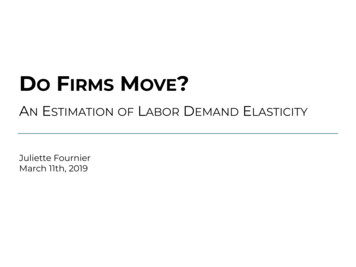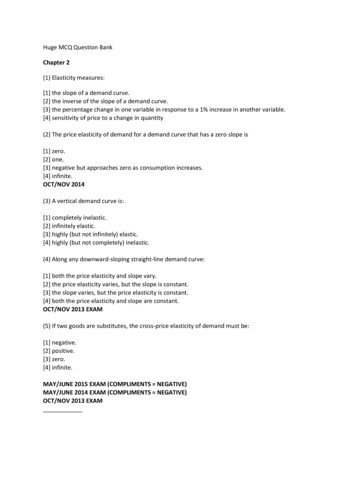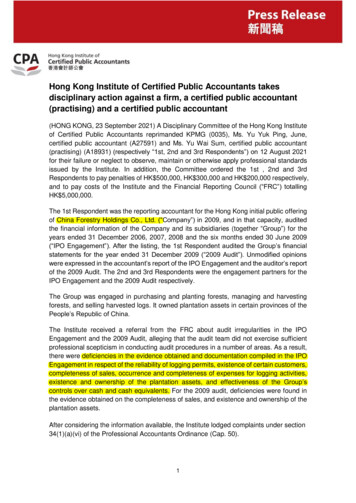
Transcription
DO FIRMS MOVE?AN ESTIMATION OF LABOR DEMAND ELASTICITYJuliette FournierMarch 11th, 2019
Introduction
INTRODUCTIONWHY SHOULD WE CARE ABOUT FIRM MOBILITY?REGIONAL DYNAMICScrucial to explain long-lasting impact of local shocksPLACE-BASED POLICIESfactor determining the success and incidence of such programsLDKEY STATISTIC: WAGE ELASTICITY OF LOCAL LABOR DEMAND εlocal3
INTRODUCTIONUNDERSTANDING REGIONAL DYNAMICS Primitive allowing to reinterpret reduced-form effectsSPATIAL EQUILIBRIUM FRAMEWORK: BLANCHARD, KATZ (1992)stationary wages and unemployment rateemployment permanently affected LSLDlong-run impact determined by relative magnitudes of εlocaland εlocaldo new firms settle down faster than workers move out?EMPIRICAL EVIDENCE: PERSISTENCE OF LOCAL SHOCKSAutor et al. (2013), Mian and Sufi (2014), Dix-Carneiro and Kovak (2017) why don’t new firms move in?4
INTRODUCTIONARE PLACE-BASED POLICIES EFFICIENT? Primitive determining the success of place-based policiesARE PLACE-BASED POLICIES EFFICIENT?Kline, Moretti (2014)WORKERS RELOCATE, LOCAL RENTS RISEno welfare gain but a deadweight lossINELASTIC LOCAL LABOR DEMAND?costly subsidies, no job creation5
INTRODUCTIONTHE ELASTICITY OF LOCAL LABOR DEMAND Two components: Production and mobilityPRODUCTIONsubstitution of labor for capitalscale change conditional on location, how many workers will a firm hirefollowing a wage decrease?MOBILITY how many firms will choose to move to some area following alocal wage decrease?STRATEGYexploit the implementation of enterprise zones in Frenchdistressed urban areas6
INTRODUCTIONLITERATUREPOLICY EVALUATION OF ENTERPRISE ZONESBusso, Gregory and Kline (2013): Empowerment Zone programKline and Moretti (2014): Tennessee Valley AuthorityZFU evaluation: Rathelot and Sillard (2008), Gobillon et al. (2012),Givord et al. (2013)ESTIMATION OF LOCAL LABOR DEMAND ELASTICITYHamermesh (1993), Angrist (1996)but few papers on firms’ mobilityexception: Suarez-Serrato and Zidar (2016)1.spatial equilibrium model with imperfectly mobile firms and workers2. exploit changes in state corporate taxes within the U.S.3.LDfinding: εlocal -2 to -2.5 firms are not very mobile7
OUTLINE1. The Enterprise Zone Program2. Identification Strategy3. Structural Model4. Estimation of Reduced-Form Effects5. Estimation of Structural Parameters8
The enterprise zoneprogram
THE ENTERPRISE ZONE PROGRAMTHE ZFU PROGRAMENTERPRISE ZONE PROGRAMtax credits for distressed urban areas3 NESTED LEVELS OF PRIORITY1.ZUS (sensitive urban zone) 751 zones established in 1996nearly 5 million inhabitants2. ZRU (urban renewal zone) 416 zones defined in 1996 2/3 of the ZUS population3. ZFU (urban tax-free zone) selected using a synthetic index3 waves: 38 in 1997, 41 in 2004, 15 in 200610
THE ENTERPRISE ZONE PROGRAMMAP OF THE ZFUS19972004200611
THE ENTERPRISE ZONE PROGRAMTAX EXEMPTIONSTAX CREDITScorporate taxpayroll taxlocal business taxreal estate taxEXEMPTIONS IN BOTH ZRUS AND ZFUStotal exemption for the first few years, then partial and decliningduration substantially larger in ZFUs than in ZRUsinstitutional details12
1997194, avenue du Président Wilson93217 SAINT DENIS LA PLAINE CEDEXTHE ENTERPRISE ZONE PROGRAMIle de France 11Yvelines (78)ZONE FRANCHE URBAINEAN EXAMPLE OF ZFU: MANTES-LA-JOLIECarte au 1/25000 visée à l'article 1du décret n 96-1154 du 26 Décembre 1996Commune : Mantes-la-Jolie.ZFU: Le Val Fourré.N INSEE: 11060ZF13La zone concernée est délimitée par un trait de couleur rouge.(c) IGN 1/ 25000 Carte(s) :2113E (89)
Identification strategy
IDENTIFICATION STRATEGYONLY PAYROLL TAXln wΔ ln wLS{pre taxΔ ln w post tax{{LDln LΔ ln LLDLSεεIDENTIFY BOTH w AND wεwLSΔ ln L ,post taxΔ ln wεwLDΔ ln L Δ ln w pre taxsee Zoutman, Gavrilova and Hopland (2018)15
IDENTIFICATION STRATEGYBOTH PAYROLL TAX AND CORPORATE TAXln wLSΔ ln w post tax{{LD′LDΔ ln Lln LεwLS IDENTIFIED AS BEFOREεwLSΔ ln L Δ ln w post tax16
IDENTIFICATION STRATEGYBOTH PAYROLL TAX AND CORPORATE TAXln w{Δ ln w̃ pre taxLSΔ ln w pre tax {{LD′LDΔ ln Lln LIDENTIFICATION OF εwLDΔ ln w̃pre tax change in pre-tax wage that would rationalize Δ ln Lif the LD curve hadn’t movedthen:εwLDΔ ln L Δ ln w̃pre tax17
IDENTIFICATION STRATEGYBOTH PAYROLL TAX AND CORPORATE TAXln w{Δ ln w̃ pre taxLSΔ ln w pre tax {Δ ln w c {{{Δ ln L cΔ ln LLD′LDln LIDENTIFICATION OF εwLDΔ ln w̃pre tax change in pre-tax wage that would rationalize Δ ln Lif the LD curve hadn’t movedthen:εwLDΔ ln LΔ ln L Δ ln w̃pre tax Δ ln w pre tax Δ ln w c18
IDENTIFICATION STRATEGYBOTH PAYROLL TAX AND CORPORATE TAXln wεcLDccΔln(1 τ) Δlnw{εwLDLSΔ ln L c εcLDΔ ln(1 τ c)LD′LDln LIDENTIFICATION OF εwLDεcLDcΔln(1 τ) pre-tax wage shock that would shift LD to LD’LDεw19
IDENTIFICATION STRATEGYBOTH PAYROLL TAX AND CORPORATE TAXln w{Δ ln w̃ pre taxLSΔ ln w pre tax {εcLDΔ ln(1 τ c)LD{εw{LD′LDln LΔ ln LIDENTIFICATION OF εwLDεcLDcΔln(1 τ) pre-tax wage shock that would shift LD to LD’LDεwεwLDΔ ln LΔ ln L pre taxεcLDΔ ln w̃Δ ln w pre tax εLD Δ ln(1 τ c)w20
IDENTIFICATION STRATEGYBOTH PAYROLL TAX AND CORPORATE TAXln w{Δ ln w̃ pre taxLSΔ ln w pre tax {εcLDΔ ln(1 τ c)LD{εw{LD′LDln LΔ ln LεwLDASSUMPTIONS1.Δ ln LΔ ln L pre taxεcLDΔ ln w̃pre taxΔ ln w εLD Δ ln(1 τ c)wΔ ln(1 τ c) is knownLDε2. c can be expressed in terms of known parametersεwLD21
IDENTIFICATION STRATEGYIDENTIFICATION STRATEGY: STRUCTURAL MODELSTRATEGY: STRUCTURAL MODEL1.spatial equilibrium model characterizing both firms’ location andproduction choices2. decompose LD into 3 margins: intensive margin, within-cityextensive margin, across-city extensive marginεcLD3. for each margin, use the structural model to expressin termsεwLDof known parametersIDENTIFICATION ASSUMPTIONS{exact magnitude of the corporate tax shock Δ ln(1 τ c) measurableεcLDvalue ifknownεwLDno entrepreneurial margin22
Structural model
STRUCTURAL MODELHOUSEHOLDSHOUSEHOLDSmass 1 of householdssupply inelastically 1 unit of laborPREFERENCESCES preferences on goods νlocation choice: nested logit model over amenities ACobb-Douglas aggregation of consumption and locationmax ln A ln(xν)( ν Fε PD 1ε PDxνdν)ε PDε PD 1such that ν Fpν xνdν w24
STRUCTURAL MODELHOUSEHOLDS: LOCATION CHOICELOCATION CHOICE: NESTED LOGIT MODEL OVER AMENITIES Alocal amenity Ah,cncommon location-specific component Ācnidiosyncratic component ξh,cnnested logit model: ξh,cn generalized extreme value distribution 2 nested geographical levels: neighborhood n and city cσ W dispersion parameterλ W [0,1] within-city correlationthink of a ZFU as a neighborhood within a given cityEQUILIBRIUM POPULATIONLc in city c, Lcn in neighborhood n of city c25
STRUCTURAL MODELHOUSEHOLDS: LOCATION CHOICEINDIRECT UTILITYWVh,cn a0 ln wcn ln Ah,cn a0 ln wcn ln Acn ξh,cn ucnCITY POPULATIONWWLc ℙ n, Vh,cn max Vh,c′ n′[]c′,n′λWNcucn /σ W λ W( n 1 e)CNc c 1 ( n 1 e ucn/σW λW)λWNEIGHBORHOOD POPULATIONucn /σ W λ WLcne NW WLc n′c 1 e ucn′/σ λ26
STRUCTURAL MODELLABOR SUPPLY ELASTICITY ln Lcn /Lc Lcn ln Lc ln wcnLc ln wc{εwLSLD εwithinACROSS-CITY COMPONENTLDεacross{DECOMPOSITIONLD εacross1 W (1 Lc)σhow much does city LS increase after a rise in city average wage?WITHIN-CITY COMPONENTLSεwithinLcn1 W W 1 σ λ (Lc )how much does neighborhood relative LS increase after a wagehike in the neighborhood?27
STRUCTURAL MODELESTABLISHMENTSESTABLISHMENTSmonopolistically competitiveproductivity Bf,cn depends on location (c,n)PRODUCTION FUNCTION1 α βα βyf,cn Bf,cnkf,cnlf,cn Mf,cnwith Mf,cn ( ν F(xν, f,cn)ε PD 1ε PDdν)ε PDε PD 1intermediate goodsPROFITScwπcn, f (1 τcn) pcn, f ycn, f (1 τcn)wcnlcn, f pν xν,cn, f dν ρkcn, f ν F()cwwith τcnlocal corporate tax rate, τcnlocal payroll taxreturns to equity holders not tax deductible28
STRUCTURAL MODELESTABLISHMENTS: PROFITSPROFIT MAXIMIZATIONπf,cn cw(1 τcn) pf,cn yf,cn (1 τsc)wcnlf,cn pν xν, f,cndν ρkf,cn ν Flf,cn,kf,cn,(xν, f,cn),pf,cn()maxLOCAL PROFITSπf,cn (1 cτcn)(1 w (ε PD 1)β (ε PD 1)β (ε PD 1)ατcn)wcnρ(1 c (ε PD 1)α (ε PD 1)τcn)Bcnκ29
STRUCTURAL MODELESTABLISHMENTS: LOCATION CHOICELOCATION CHOICE: NESTED LOGIT MODEL OVER PRODUCTIVITY Blocal productivity Bf,cncommon location-specific component B̄cnidiosyncratic component ζf,cnnested logit model: ζf,cn generalized extreme value distribution 2 nested geographical levels: neighborhood n and city cσ F dispersion parameterλ F [0,1] within-city correlationEQUILIBRIUM NUMBER OF ESTABLISHMENTSEc in city c, Ecn in neighborhood n of city c30
STRUCTURAL MODELLABOR DEMANDLOCATION CHOICE: VALUE FUNCTIONFVf,cn ( (ε PD 1)1 α ln(1 )cτcn) Bcn β ln(1 wτcn)ln κ β ln wcn α ln ρ ζf,cnPD (ε 1) vcnNUMBER OF ESTABLISHMENTSλFEc Ncvcn /σ F λ F( n 1 e)c c 1 ( n 1e vcn/σF λF)CNλFvcn /σ F λ FEcne NF FEc n′c 1 e vcn′/σ λandAVERAGE NUMBER OF EMPLOYEESw βεl*cn 𝔼ζ l*(c,n) argmax{V} (1 τ)f,c′n′cnf,cn[](c′,n′)PD β 1βεwcnPD β 1 (1 ε PD)αρcn(1b (ε τcn)PD 1)ακe (εPD 1)Bcnzcn31
STRUCTURAL MODELLD ELASTICITY WITH RESPECT TO WAGEDECOMPOSITIONLD, ext εwithin,wLD, ext εacross,wextensive marginACROSS-CITY COMPONENTLD, extεacross,wWITHIN-CITY COMPONENTLD, extεwithin,w{{{ cn lnE/EE lnE lnl*cnccncεwLD ln wcnEc ln wc ln wcn εwLD, intintensivemarginβ F (1 Ec)σEcnβ F F 1 σ λ (Ec )INTENSIVE MARGIN COMPONENT{{εwLD, int β 1 βε PDsubstitution scale32
STRUCTURAL MODELLD ELASTICITY WITH RESPECT TO CORPORATE TAXACROSS-CITY COMPONENT ln Ecμ 1 αLD, ext ε (1 E)across,cc ln(1 τcc)σFwith μ 1 1 (ε PD 1)net markupWITHIN-CITY COMPONENTLD,extεwithin,cEcnμ 1 α 1 FFσ λEc )(INTENSIVE MARGIN COMPONENTεcLD, int α αε PD33
STRUCTURAL MODELRATIOS εc /εwACROSS-CITYLD, extεacross,cμ 1 α βLD, extεwithin,cμ 1 α βLD, extεacross,wWITHIN-CITYLD, extεwithin,wINTENSIVE MARGINεcLD, intεwLD, int α αε LDα β 1 βε LDβ μ 134
STRUCTURAL MODELSTRUCTURAL EQUATIONS SYSTEMSTRUCTURAL EQUATIONS SYSTEMAYcn,t BZcn,t ecn,twith[Ycn ]Δ ln wcn(Lc /Lcn)Δ ln LcΔ ln Lcn /Lc(Ec /Ecn)Δ ln EcΔ ln Ecn /EcΔ ln Lcn /EcnZcn [1ZFU]ESTIMATE REDUCED-FORM EFFECTS ON OUTCOMES OF VECTOR Y35
Estimation ofreduced-form effects
ESTIMATION OF REDUCED-FORM EFFECTSDATAADMINISTRATIVE DATA: DADS, SIRENEESTABLISHMENTS: PANEL DATA, YEARLYnumber of employeestotal number of hours workedtotal (pre-tax and post-tax) payrolllocation (street address)WORKERS: YEARLY, 1/12TH SAMPLE, VARIABLES FOR YEARS t AND t-1establishment’s identifierincomenumber of hours workedoccupationage, sex37
ESTIMATION OF REDUCED-FORM EFFECTSSOURCE OF VARIATIONIDENTIFICATION: EXPLOIT THE SELECTION OF SOME ZRUS INTO ZFUSselection based on observable criteriatax credits substantially larger and longer in ZFUs3 waves of ZFUs: 1997, 2004, 2006OTHER MARGIN: SELECTION OF ZUSS INTO ZRUS38
ESTIMATION OF REDUCED-FORM EFFECTSZFU OUTCOMES: IDENTIFICATIONSELECTION OF ZFUS AMONG ZRUSpopulation threshold ( 8 500 inhabitants)synthetic indexCRITERIA: OBSERVABLES Xtotal populationunemployment rateproportion of youthproportion of dropoutstax revenues of the cityTWO POSSIBLE ECONOMETRIC METHODS1.weighting on propensity score2. fuzzy regression discontinuity design39
ESTIMATION OF REDUCED-FORM EFFECTSWEIGHTING ON PROPENSITY SCOREIDENTIFICATION ASSUMPTIONS1. selection on observables: (Y1, Y0) 1ZFU X2. common support: 0 ℙ(1ZFU X) 1ESTIMATORαATE 𝔼 Y[ p(X)(1 p(X)) ]1ZFU p(X)with p(X) ℙ(1ZFU 1 X) propensity score40
ESTIMATION OF REDUCED-FORM EFFECTSFUZZY REGRESSION DISCONTINUITY DESIGNIDENTIFICATION ASSUMPTIONS1.unconfoundedness assumption: (Y1, Y0) 1ZFU X2. fuzzy discontinuity:0 lim ℙ(1ZFU 1 Q q) lim ℙ(1ZFU 1 Q q) 1q Qq QSAMPLE RESTRICTION[Q h, Q h] with Q population threshold, h bandwidthESTIMATORτFRD limq Q 𝔼[Y Q q] limq Q 𝔼[Y Q q]limq Q 𝔼[1ZFU Q q] limq Q 𝔼[1ZFU Q q]41
ESTIMATION OF REDUCED-FORM EFFECTSCITY OUTCOMES: IDENTIFICATIONOUTCOMES(Lc /Lcn)Δ ln Lc(Ec /Ecn)Δ ln Ecover-identification equation Δ ln Qc /EcSYNTHETIC CONTROLSfor each city hosting a ZFU to obtain the impact of being a ZFU oncity-c outcome ΔYcthen OLS:ΔYc β εcwith β expected impact of becoming a ZFU42
Estimation ofstructural parameters
ESTIMATION OF STRUCTURAL PARAMETERSSTRUCTURAL ESTIMATIONESTIMATION OF 5 STRUCTURAL PARAMETERSσ F, λ F, σ W , λ W , ε PDCALIBRATED PARAMETERSα, β, τ c, τ cMINIMUM DISTANCE ESTIMATORθ ̂ arg min[A(θ)π ̂ B(θ)]′W[A(θ)π ̂ B(θ)]θ Θwith aθ (σ F, λ F, σ W , λ W , ε PD)π ̂ vector of reduced-form effectsW weighting matrix44
Conclusion
CONCLUSIONCONCLUSIONPOTENTIAL CONTRIBUTIONSestimate city-level labor demand few papers estimating LD no previous estimate of firm city-level mobilityadvantage of this method: payroll tax variation, much sharper shockthan wage fluctuationsuncover primitives driving the effectiveness and incidence ofplace-based policiesexplain persistence of local shocksFUTURE STEPShow fast are firms moving?are some sectors more mobile than others?labor-intensive vs capital-intensive? retail stores? plants?can we predict the observed resilience to local shocks?46
Thank you!
Additional slides
ADDITIONAL SLIDESTAX EXEMPTIONSCORPORATE TAX: First total, then partial and declining exemptionZRU: 5 years overall, total the first 2 years, only newly created businessesZFU: 14 years overall, total the first 5 years, 50 employeesPAYROLL TAX: Exemption decreasing with employee incomeZRU: 5 years overall, only new recruitsZFU: 8 years overall (14 if very small firm), maximal the first 5 years, 50employees, at least 1/3 ZFU residentsLOCAL BUSINESS TAX:ZRU: 5 years overall, 150 employeesZFU: 8 years overall (14 if very small firm), total the first 5 years, 50 employeesREAL ESTATE TAX:ZRU: no exemptionZFU: total exemption for 5 yearsback49
7 LITERATURE INTRODUCTION POLICY EVALUATION OF ENTERPRISE ZONES Busso, Gregory and Kline (2013): Empowerment Zone program Kline and Moretti (2014): Tennessee Valley Authority ZFU evaluation: Rathelo










